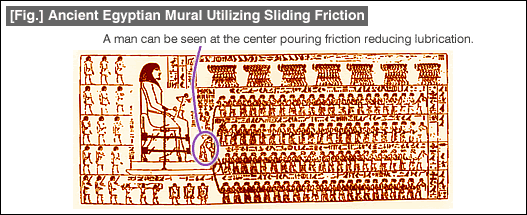#072 Sliding Guides - 2: Friction and Wear
Friction forces are generated when solid objects in contact make relative motion. These friction forces must be managed properly with lubrication and etc, or may result in troubles shown below.
1.Friction of solid objects resulting in seizures.
2.Wear begins and accelerates.
3.Increased power losses.
It is important to manage the friction and wear.
(1) About Friction
There are to types of friction.
a)Sliding Friction
b)Rolling Friction
The sliding friction is the type seen with Gib Slides (previous Vol.), skies and sleds. The [Fig.] shown below is an ancient Egyptian mural. It depicts a scene of transporting a large stone statue. A man can be seen at the center pouring friction reducing lubrication.

Show below are friction coefficients of various material combinations.
|
The rolling friction can be represented by Linear Motion Guides (previous Vol.), miniature ball guides, and etc. where friction occurs with balls and rollers. If the sliding friction is to be defied as the "Sled Era", the rolling friction can be dabbed as the "Rolling Cart Era".
Rolling friction coefficient examples are shown below. (Sliding friction coefficient and rolling friction coefficient cannot be compared equally.)
|
(2) About Wear
When solid objects are in contact without any lubrication between them, minute surface features are in directly coupled states. Friction occurs when this coupled features are decoupled by sliding motion, and this is the friction resistance (force). When the decoupling occurs, minute sections of material is ripped away where contacting. This is the wear. When the friction increases, the wear simply increases also.
Proper lubrication is needed to prevent wearing. Selecting appropriate lubrication is important, especially for mechanisms with high motion speeds and clean room applications.- Positioning technology
- Designing and processing
- Sensor Technology
- Automation elements technology
- Clean room technology
- Design hints
- Design tips
- Designing and Machining
- Drive mechanism design
- Hints on designing
- Linear Motion Components
- Locating Technology
- Manufacturing technology
- Motion mechanism design
- Pneumatic Drives
- Production Technology
- Technology Outlook
- General description
- Low-cost automation and materials
- Transfer LCA
- #333 Know-how on automation: Pressurized heating technology - 5: Multilayer pressurized heating process technique
- #332 Know-how on automation: Pressurized heating technology - 4: Points to remember when designing mechanism of pneumatic pressurization method
- #331 Know-how on automation: Pressurized heating technology - 3: Pneumatic pressurization method and pressure profile
- #330 Know-how on automation: Pressurized heating technology - 2: Pressurization method and pressure profile
- #329 Know-how on automation: Pressurized heating technology




